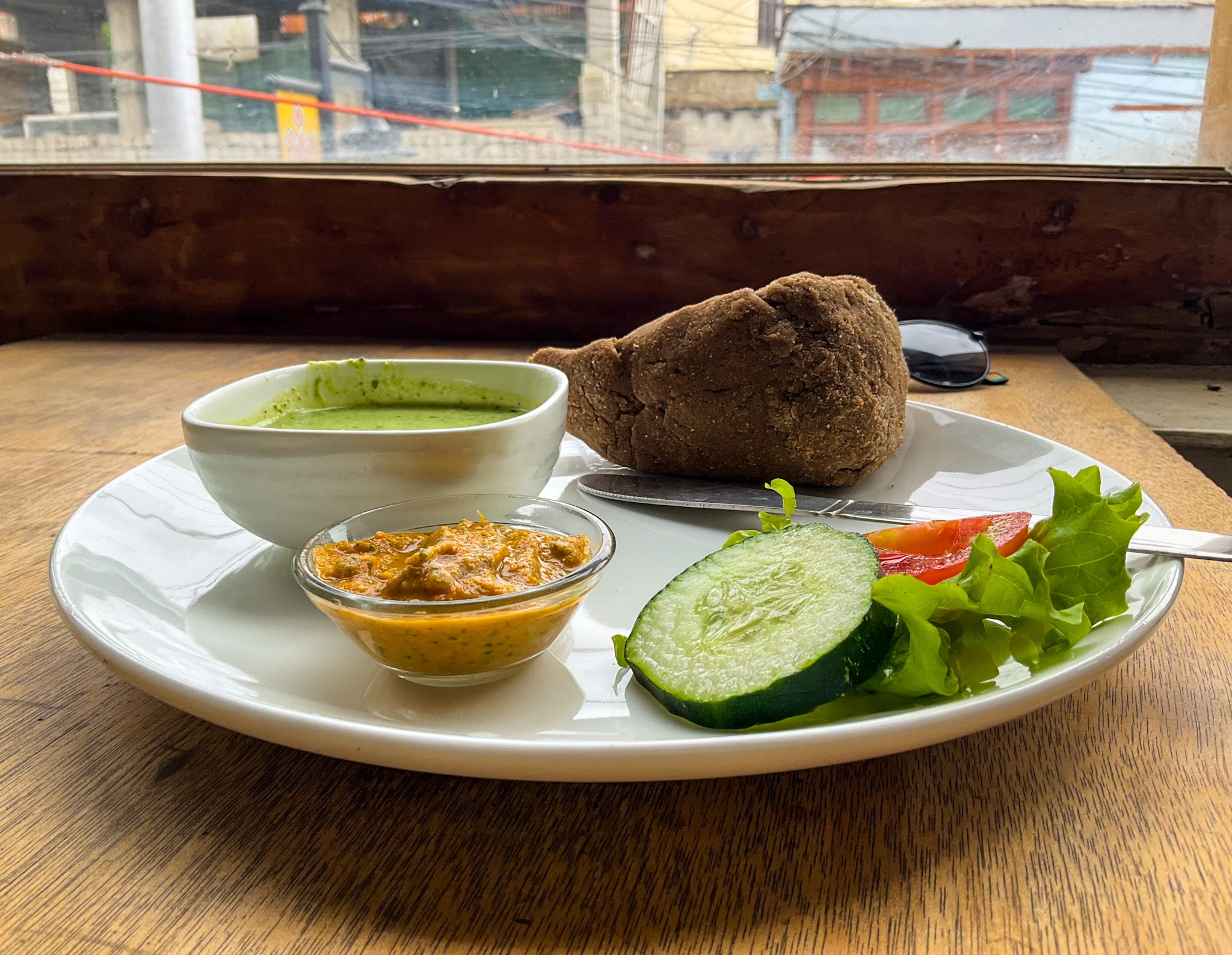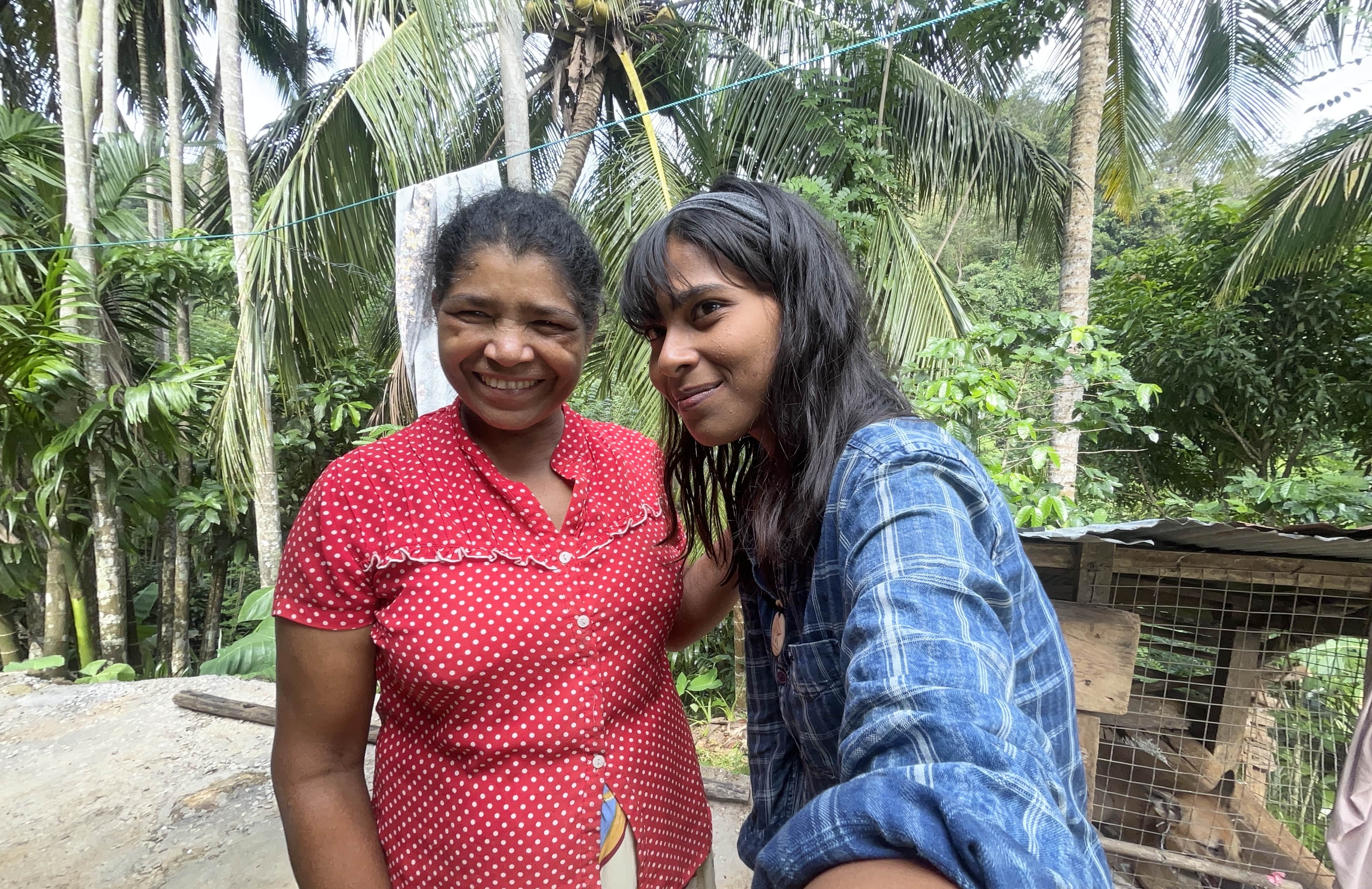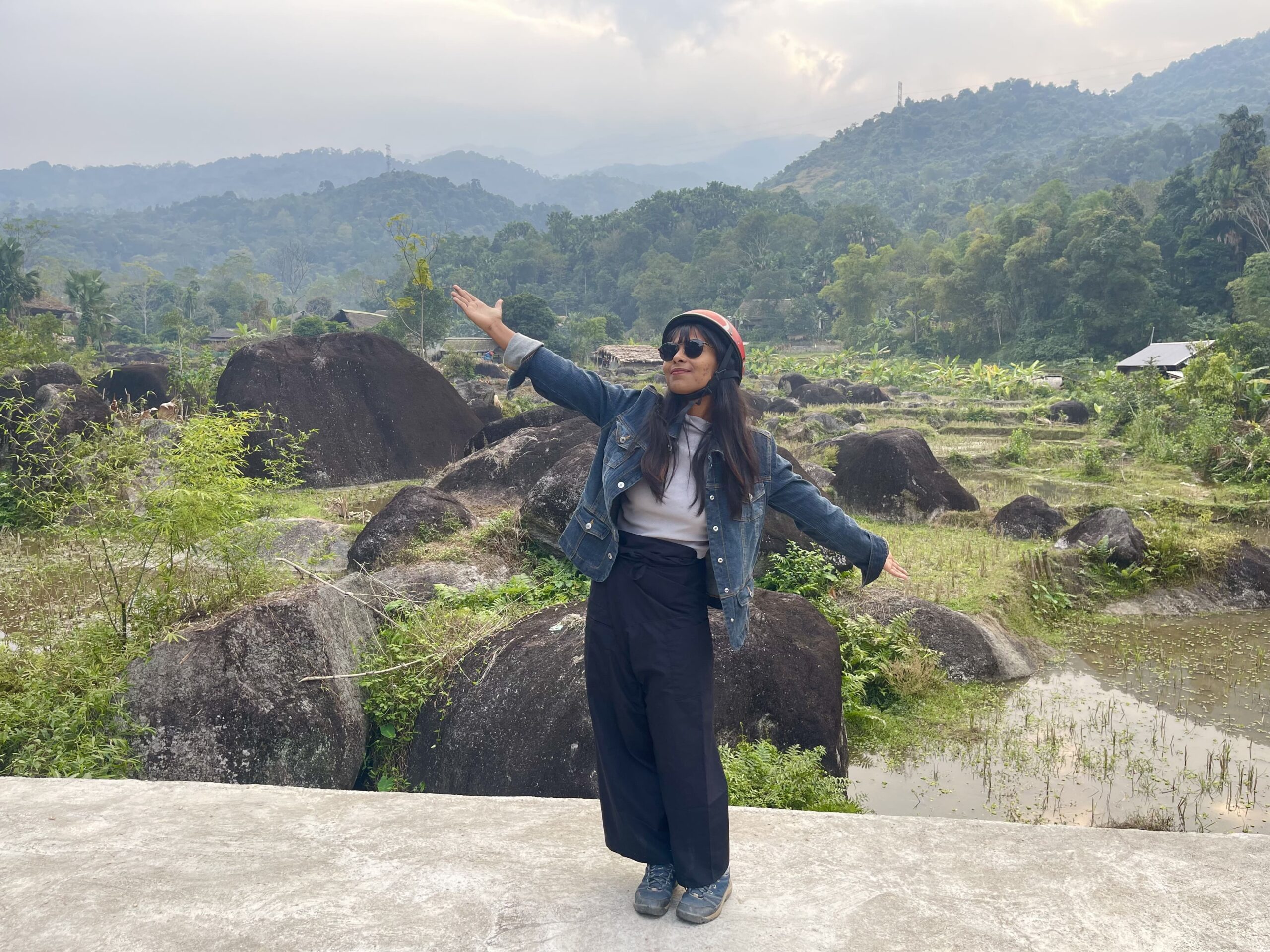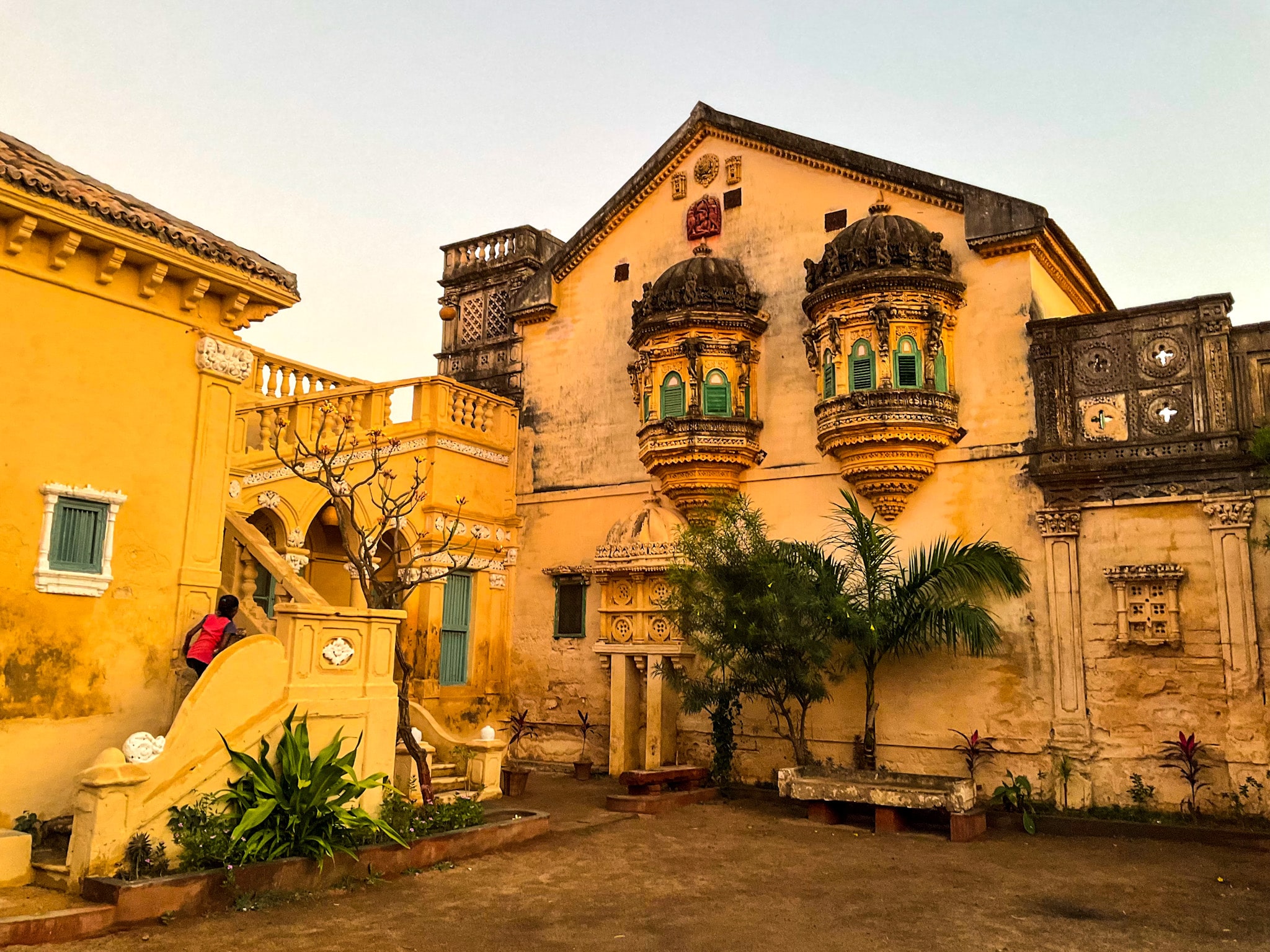Understand the singularity of this unique region through the long-tailed traditions of food in Ladakh. The cuisine is alive in self-sustaining barley, wheat, apricots and more! From the ancient silk route to the traditional agricultural methods, the Ladakhi cuisine evolved and molded with circumstances.
‘Ladakhi food traditionally is very bland. Dry cheese (chhurpe), black and brown peas, wheat, and barley… But now that people are aware of greenhouses, they have added more leafy vegetables to the cuisine.’

The kitchen hearths or thaps have attuned Dolma’s childhood in Sham Valley to treasuring the olden Ladakhi recipes, now transfused by slabs of simplified connectivity. Dolma is also a mountaineer and runs her own women-only travel company under ‘Dolma’s Trails’. It wasn’t until she met Radha from Nepal during their fellowship on social entrepreneurship in Ladakh that their unmade thoughts rotated far into an idea, the local-only enterprise ‘De Khambir’ in 2019. An endeavor to promote Ladakhi food, often mistakenly impersonated as the influential Tibetan cuisine.
‘We source everything from the local farmers around, except onion, garlic, and a few other things. Apricot comes from Takmachik village in Khaltsi. Once you travel this far, you should have one authentic dish.’ Radha Shrestha, now advocating her all-natural skincare brand Yoza, shares how she makes 100-percent-natural soap using lye, apricot oil, and sodium hydroxide through the saponification process.
‘The important thing is to balance the nutrition in food. Proteins, vitamins, fats… Dolma knew the recipes, I made some fusions.’ De Khambir is on the rise in Leh Market in their little wooden first-floor cabin.
Also read – Lamas Dancing in Masks at Phyang Festival Ladakh
The Influence of the Silk Route on Food in Ladakh

Ladakh, an outlying cold desert thriving on high-altitude settlements through the summer-window of vegetation. Cut-off from the chimes of the world, Ladakh’s daily economy revolted in pastoral farming and self-sustaining pint-sized handy-techniques to survive through the -30° harrowing nights. Yet their ancient agricultural methods had always motivated self-sustenance through small-acre divisional farming. Wheat, barley, and hardy cash crops made up for their staples, and cheese, yogurt (zho) and, buttermilk (Tara) were only transmuted into traditional drinks. ‘My 98-year-old grandfather still eats Paba and Thangthur – and going strong with age’, Rizzi, the local cab driver told me on a hitchhiking ride from Keylong to Leh.
“Ladakh used to be self-sufficient in regards to food, clothing, and housing, but today it imports more than 80% of the products.”
The ancient silk route brought with it the whiff and nudge of the far-flung lands of Tibet, China, the Middle East, and Dardistan. The eastern Ladakh bartered dairy products for salt with Tibet and Zanskar. Ladakhi claims traveled beyond its Tibetan and Mongolian roots, their lineage can also discern Dards, a European Aryan race. Far and together, the binding cultural confluence impacted the slow evolution of food in Ladakh.
Mokmok, Thupka, Thenthuk, Tingmo…. The Tibetan delicacies intermingled with Ladakhi plates. Once the silk route was obviated and trade ceased to partake in Ladakh, they had to curate their own cuisine by cultivating a self-sustaining pulverized agricultural economy that could utilize the resources at hand.
It was only after the Srinagar-Leh Highway opened in 1962 that the external world brought rice and other ingredients in its sack to eventually substitute the daily meals in Ladakhi households. The Sino-Indian War of 1968 demanded a strong army presence which continues to be an extrinsic inference to their agricultural system.
Also read – Zanskar in the Lights & Shadows of Life
Agricultural System for the Harsh Winters

‘Vegetables come in planes to Leh in the winter months. We can just buy vegetables now, even though it’s quite expensive. Tomato is Rs. 150/kg.‘ Sonam Auntie told me while preparing Thalthak for me, as we conversed more on traditional dishes. Thalthak is a fluffier-than-roti Ladakhi bread.
Preservation and lacto-fermentation ensure a hard winter story that submerges in meek despair. Being stranded as snow-white land for seven months, the Ladakhis sun-dry and powder the leafy vegetables and store the root vegetables in cold underground cellars. Apricot (chulli) and sea buckthorn (chasta ruru) are made into jams and preservatives. Wild caper shoots are pampered in a relish. As summer flashes back in, irrigation demands seasonal snowmelt glacial water to hose down the farmland. With climate change pouncing on, the navigation of melted-water loses its time and Leh experiences a solid depletion of water.
-What do you do on those harsh winter days?
-We drink Gur-Gur Chai with our family. Summer months are all about work, and winter is for Butter Tea and leisure.
How is Ladakh Sourcing Its Food
But how does Ladakhi food get sourced? Barley, wheat, and buckwheat inculcate the boundary of their nutritional geography. Pulses, apricots, potatoes, spinach, sugar beet, radish, peas, and Chinese Cabbage or Napa cabbage are grown during this short farming season. The small orange berries of sea buckthorn source themselves into repositories of vitamin C and saturated and polyunsaturated fats.

The usage of spices is limited to Chillies for their body-heating propensities, freshly ground pepper, fresh and dried herbs such as cilantro, Chinese celery (Chin-Tse), wild chives, onion greens, and wild horsemint for seasoning. No turmeric, garam masala, or red chili powder; the commonalities often found in Indian spreads. The only Chili for the Ladakhis is the yellow Manali Chili ‘Thanguyer’.
Carbs mostly accumulate from organic whole wheat, harvested from the ancestral fields and grounded in a rantak (traditional watermill).
Intensive sunlight, strong winds, high evaporation rate, and fluctuating temperature leave little moisture in the wizened, weather-beaten air. However, each family owns only a few acres, and their mud houses are grouped into villages whose size varies as per the availability of water.
As you travel more up to Changthang, the land of the nomadic tribes near the China border, meat consumption and pastoral farming guide their cultural break-up. In Muslim-occupied places like Kargil, Turtuk, and Hunder, the non-vegetarian streak bottles another sub-cuisine of a different sort.
Traditional Ladakhi Dishes to Try in Ladakh
Overnight soaking of dry apricots prepares Phating with the sweet deliciousness in a bowl. In De Khambir, traditions emerge with some Ladakhi desserts like Paktsa Markhu – Mini buckwheat balls cooked with local cheese butter and jaggery syrup, or Pheymar – curated with Barley, jaggery and butter. Soup also finds its flavors in stinging nettles, chhurpi soup, and Thuksing – Roasted barley, black pea, and cheese soup!
And within and beyond all variations, here are some of the traditional vegetarian dishes you must try when you are in Ladakh.
1. Skyu

Skyu is a traditional soup-based dish made out of wheat and root vegetables. The fermented wheat dough is sculpted into ear-shaped bite-sizes and cooked with carrots, potatoes, beans, peas, and fresh vegetables. Skyu is favorably consumed in winter when the temperature drops below the sub-zero point. As you add milk to it, the dish becomes Oma (milk) Skyu.
2. Chhutagi – A Variation of Skyu

Chhutagi, literally translated to “water bread”, is a slightly different rendition of Skyu. The fermented bread dough is first flattened and then cut up in circular forms. The bow-tie shapes are then cooked in a thick vegetable soup. This wholesome and nutritious Ladakhi food is usually served during the harvest season.
3. Tapu

Tapu, the local wheat delicacy cooked in apricot kernel sauce and herbs. Tapu excels in largely-occupied apricot areas like Sham Valley. Even though Apricot kernel has undergone generic controversy, dried flour is boiled in water and then mixed with finely ground apricot seeds to give it a great tender texture. “Apricot kernels are somewhat a sensitive topic, as there are reports that suggest the kernels pose a risk of cyanide poisoning. To put people at ease, EFSA’s scientific panel set the safe level for a one-off exposure to these kernels as 20 mg per kg body weight.”
4. Ladakh’s Traditional Food Choices – Paba and Tangthur

Once the staple food of Leh-Ladakh, Paba is a dry chunky bread made with tsampa (barley flour) and ground pea flour juxtaposed with boiling water. Paba is slathered with ghee and often served with Tangthur, buttermilk mixed with herbs. One of the oldest Ladakhi food-delicacies to be savoured.
5. Bread-Based Food in Ladakh
Khambir – The Local Bread
Khambir is one of the most popular dishes in Ladakh! On an iron or stone girdle, Khambir is kept over a burning fire and the thup is fired by wood or dung fuel. This traditional Ladakhi bread is a thick crust in its pan-shaped form, baked out of wheat flour, and is quite a mouthful for a stuffed starter. The Ladakhis’ days gleam with these freshly baked breads leavened with an indigenous yeast called pul.

Besides Khambir, Tagi Buskhuruk (Puffed unleavened bread) is the same as tagi shrabmo, but the rounds are thicker and smaller in size. Tagi Thalkhuruk, tagi thalshrak, tagi Mer-Khour, tagi Thal-Khour, tagi Tain-Tain, tagi Kiseer/Giziri, Skien/Mayaro are many varieties reigning across the region. Kaptsey/Makhori is presented when a girl child is born. In Shin and Balti tribes in the Kargil district, the groom’s family gifts this to the bride’s family during the betrothal and marriage ceremonies.
But how does Ladakhi food get sourced? Barley, wheat, and buckwheat inculcate the boundary of their nutritional geography. Pulses, apricots, potatoes, spinach, sugar beet, radish, peas, and Chinese Cabbage or Napa cabbage are grown during this short farming season.
6. Rice-Based Ladakhi Food: The Future Additives
Tsochik & Dasthuk
Rice has picked up the Ladakhi food-chain only recently. With spiriting or dispiriting tourism and a reluctance to adhere to the old means, rice is slowly plunging into the easier avenues. “Ladakh used to be self-sufficient in regards to food, clothing, and housing, but today it imports more than 80% of the products.” Mixed rice with fresh vegetables dishes up Tsochik. Rice porridge soup, adapted with vegetables and cheese to Dasthuk.

Yarkhandi Polao
One of the fewest rice-dishes from the ancient trade days is Yarkhandi pulao, a course from Yarkhand in China, transported to Ladakh along the southern tributaries of the Silk Route and was treated as a novelty decades back. More on the non-vegetarian side in Ladakhi food, time has also presented its vegetarian allure, prepared with julienned baby carrots, long basmati grains from Jammu, and aromatic whole spices.
Also read – Kargil Beyond Its Projections of the India-POK Border
Drinks of Ladakh – Let’s Start with Gur-Gur Chai!

1. Gur-Gur Chai (Salty Tea)
In a long brown tube, tea, hot water, salt, and butter are churned. The churned tea is then transferred to an earthenware kettle. The pink colour comes from a process of over-brewing the tea leaves in tiers. Often diluted with slobbery butter, Gur-Gur Chai keeps pouring on the Ladakhi cups till the end that may never come. One must try Salty Butter Tea when in Ladakh!
2. Sea Buckthorn Juice

Locally known as Leh berries, the Sea buckthorn plants were relatively unfamiliar till some decades ago. The Ladakhis use tart berries to make juice as well as syrup for the winter for its vitamin C propensities. A glass of revitalizing refreshment on a sweltering hot day with your share of Ladakhi food!
3. Cha Chul & Khunak Tea

Khunak is the black salty tea. And Cha Chul is unique in its barley. ‘Add as much barley as you want, it’s local’, Sonam from Amchi Guest House in Lamayuru served Cha Chul in a bowl, more like a soup with the long-necked barley container.
4. Chhang – The Alcoholic Beverage of the Himalayas
Chhang, a mild beverage with 5-7% alcohol intake, is locally brewed from fermented barley. Still prevalent as a token of festivity, accepting and drinking chhang from the prospective groom’s family settles the wedding knot. Before the guests, Chhang is served with a small piece of butter on the edge of cups as a sign of respect. A finger is dipped and a few drops of chhang are flickered in the air thrice as an offering to the Buddha, Dharma, and Sangha before drinking. Even at the auspicious tick of a child’s birth, family and neighbours bring chhang to the newly-made parents along with butter and flour.

It is said that the locals prepare almost 60 traditional dishes splattered over the regional nuances and livelihood patterns. The quest for Ladakhi food only finds new names in the crucible of a new village, for the singularity of this region retrieves many cultural tubers.
Choosing locally-sourced meals from a regional restaurant or household bolsters both the local economy and a traveller’s curiosity. Distinct from any other Indian cuisine, food in Ladakh flourishes in its harsh-climate ingredients as an example of how a precarious economy like Ladakh’s can be self-sustaining!
Would you like to try out some of these traditional dishes from Ladakh?
Support my solo adventures across the globe by joining the Patreon community!
Live the Adventure
Get weekly articles delivered to your doorstep and stay up-to-date with my new travel stories.





Leave a Reply